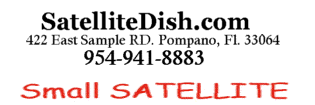





FCC Over-the-Air Reception Devices Rules. (the best place to start)
SATELLITE DISH ZONING PREEMPTION CLARIFIED; NEW PROCEDURES FOR ENFORCEMENT ADOPTED; CHANGES IMPLEMENT REQUIREMENTS OF TELECOM ACT (IB DOCKETS 95-59, 96-34)
The Commission has acted today to revise its 1986 rule preempting certain local regulations of satellite earth station antennas to ensure that all Americans are able to have as many choices as possible for delivery of video programming and to facilitate access to all satellite services. This action was taken, in part, in response to evidence that some local jurisdictions were inhibiting the growth of satellite services by enforcing overly restrictive and unreasonable zoning laws. In addition, the Telecommunications Act of 1996, Section 207, directs the Commission to preempt non-federal restrictions that impair reception by antennas used in certain direct-to-home video services including Direct Broadcast Satellite services.
In crafting the new rule, the Commission carefully considered the important interests of state and local authorities in managing land use in their communities. Against those interests, it balanced the federal interest in ensuring easy access to satellite-delivered services, which have become increasingly important in the last few years and are dependent upon rapid and inexpensive antenna installation. The revised preemption rule adopted today accommodates both federal and state and local interests and provides the FCC with a method of reviewing disputes that will avoid excessive federal involvement in local land-use issues.
The newly adopted rule makes several changes in the Commission's preemption policies. The Commission said it will review local disputes after exhaustion of only non- federal administrative remedies, not all litigation remedies as was previously required. It also adopted new standards to determine reasonableness of non-federal regulations, and created two categories of rebuttable presumptions against regulation of small antennas. These categories include antennas one meter or less in all areas and those two meters or less in commercial areas. Under the new rule, local jurisdictions would be limited to enforcement of justifiable health and safety regulation of these smaller antennas. It also adopted procedures by which non-federal authorities can request waivers of the rule in cases where unusual circumstances are shown.
The Commission tentatively concluded that its adopted rule is a reasonable way to implement Section 207 insofar as governmental restrictions are concerned. It seeks comment on whether there is any procedural mechanism that might further Congress's special concern with DBS even more effectively than the presumption approach it has adopted. It also proposed to add a new paragraph to the preemption rule in order to implement Congress's intent with regard to private, nongovernmental restrictions on satellite antennas.
Action by the Commission February 29, 1996, by Report and Order and Further Notice of Proposed Rulemaking (FCC 96-78). Chairman Hundt, Commissioners Quello, Barrett, Ness and Chong, with Commissioners Barrett and Chong issuing separate statements.
- FCC -
News Media contact: Rosemary Kimball at (202) 418-0500. International Bureau contact: Rosalee Chiara at (202) 418-0754.
February 29, 1996
SEPARATE STATEMENT OF
COMMISSIONER RACHELLE B. CHONG
Re: Preemption of Local Zoning Regulation of Satellite Earth Stations,
IB Docket No. 95-59, Implementation of Section 207 of the Telecommunications
Act of 1996, IB Docket No. 96-34, Report and Order and Further Notice of
Proposed Rule Making
In crafting our new satellite zoning preemption rule, we have diligently tried to balance the federal interest in ensuring easy access to satellite services with the interest that state and local authorities have in managing land use in their communities. Having worked for many years with state and local agencies on land use issues relating to wireless facilities, I am very much aware of their concerns. Ultimately, we believe that the best way to accommodate these competing interests is to adopt a reasonableness standard for larger satellite dishes and a presumption approach for smaller satellite dishes. In sum, it is my goal to encourage widespread use of these new and successful satellite services, while still providing state and local jurisdictions with some appropriate measure of discretion. Further, in crafting our rule, we have endeavored to keep it as simple as possible, although I wonder if we have fully succeeded.
In this item, we recognize that the parties to this proceeding have not had an opportunity to comment on the impact of the Telecommunications Act of 1996 on our rule. Section 207 of the 1996 Act directs the Commission to preempt nonfederal restrictions on certain direct-to-home video services, including Direct Broadcast Satellite (DBS) services. I write separately to encourage commenters to provide us with input on whether the presumption approach we have adopted for small satellite dishes is the best way to achieve Congress' stated intent regarding DBS dishes. Finally, I hope consumers, the satellite industry, and state and local jurisdictions will let us know if there are more ways to simplify the rule while still being sensitive to the important competing interests at stake.